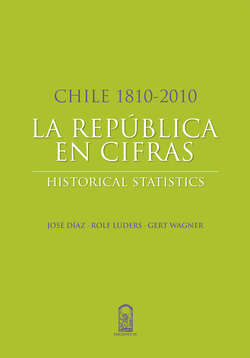Читать книгу Chile 1810-2010: La República en cifras - Jose Luis huertas Diaz - Страница 20
Nature of the indicators
ОглавлениеSeries listed in this volume correspond to homogeneous indicators constructed by authors on the basis of background information gathered for this purpose. The following paragraphs briefly explain, first, why the series are identified as constructions and then, why homogeneity and continuity was sought. Very few of these series correspond to what might be called simple transfers, i.e. copying existing series from their sources. This is so in spite of several important intertemporal consolidation efforts which can be found in some of the work of official statistical agencies and some other sources.
To construct a typical series and once basic partial information was gathered and evaluated for its representativeness, different components were assembled to generate continuous and homogeneous series. Although the basic information contained in any one partial series responds to the same general concept as that of other partial series, their start and end levels may not coincide. If so, the construction of complete series requires to fit these partial components together. This was done with enough transparency so that interested users can visualize the process.
Occasionally, too, there was competitive information, whether parallel basic statistics, or third party constructions. In these cases the challenge was to select the most appropriate component and state in the book the reasoning that led to the decision by the constructors of the series. In occasions in which available data showed an empty stretch, a number of options were available: to publish the series including a stretch without information, build a bridge or, possibly, forego publication of this series altogether. The book seeks to be explicit about these matters, so that those who want to explore particular facets of Chilean development can make informed decisions.
That the series of this book are constructions is also revealed in the choice of weights used in pertinent cases. For example, to add the production of two goods, say meat and wheat, prices may have to be used. If different price series are available, occasionally series constructed using different weights are compared and then the series which shows the most plausible evolution –in the particular historical context– is chosen to be included in the book. In these cases, both the reasoning as well as the ingredients used to reach a decision on these matters is disclosed in accompanying notes to respective chapters. In this way users will always have background information to construct an alternative series to the one presented in the book, if they think this is advisable.
The choice of unit of account is another decision authors faced multiple times. The biggest challenges arose when going from a nominal unit of account, that is, from values expressed in any legal currency, to values here termed as real. To obtain the latter, adjustments had to be made to the original series to correct for any changes in the purchasing power of the pertinent currency, as well as for changes in the legal currency. The vast Chilean experience with inflation –in the nineteenth as well as in the twentieth century– made this another facet that accompanied many of the constructions of these statistical series.
That is, in this book users can find –along with the data series and a description regarding the items used to construct these– an explanation of the procedures selected and applied to do so. At the same time, the book records criteria used to fit together partial data series, as well as sources of data consulted, both those of accepted data, as well as those of data ultimately rejected. The latter case is exceptional, since only in few cases parallel basic series were competing in the construction of a given indicator. Given the mentioned information provided, authors hope that the person who employs these series will be able to trace how series were developed to appreciate characteristics of them. In any case, as mentioned already, the book often provides enough alternative background information to enable interested parties to generate different (competing) series.
Next, a justification for the second characteristic of these series, that is, their homogeneous coverage and annual basis. Why insist on the latter and not instead present only basic information, such as reports provided by statistical agencies? This solution offers two advantages. On the one hand, a simpler and less costly procedure and on the other, results that are not associated to the idea of a construction. That is, data would simply reflect the basic observation as collected, the historical data as such, free from prejudice, technical games, or maybe even sophisticated attempts to sow deception.
